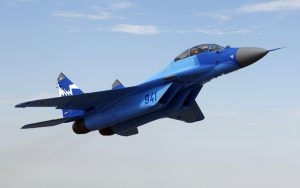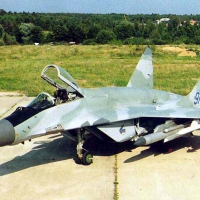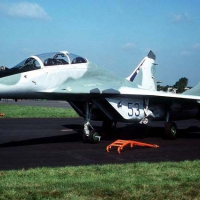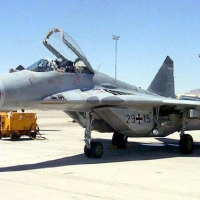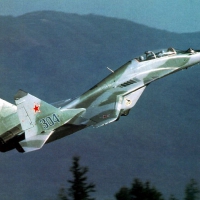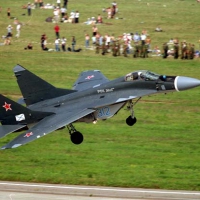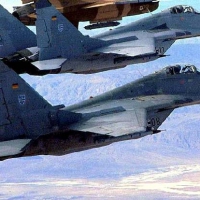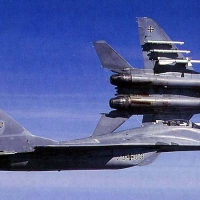MiG-29 Fulcrum
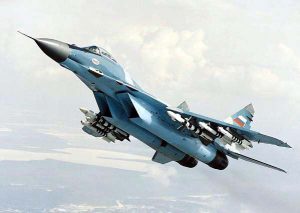 The Mikoyan-Gurevich MiG-29 Fulcrum jet was built as a reply to the Western world, as an addendom to Kruschev’s famous threat to the west, “We will bury you”. It has proven itself throughout the “cold war” and combat assignments as one of the former Soviet Union’s most advanced fighter jets. In 1979, the United States attempted to gain access to information about the MiG-29 through intelligence-gathering operations, and the use of satellites capable of photographing extremely detailed features from high altitudes. The plane was ascertained to be actively serving Russian air forces, built and validated by “design bureau”, known as the OKB. As in the past, the government of India, competitively buying against their opposition, Pakistan, negotiated with the then-U.S.S.R. to purchase 45 units of the aircraft. Afterwards, other warring nations, maintaining amicable relations with Russia, purchased hundreds more of the plane. Several components compose the electronics suite available to the MiG-29. Resting on the underside of the plane are radar warning receiver aerials, and an angle-of-attack vane, for coordinating flight instruments with the outside air pressures. Above its wings, the jet contains a common characteristic in Russian aircraft, numerous antennae, for ADF provisions, IFF functions, VHF reception, and for radar analysis. Besides its radar equipment. including a frontal scanner and conical radome, the Fulcrum includes the use of various examples of weapons technology. Fired from the plane are the R-23-type AA-9 and 10 air-to-air missiles with inertial guidance, as well as the AA-7 radar homing projectile. The R-60 AA-8 Aphid can also be used underwing in addition to this. Production of the MiG-29 continues at present, and, at last report, was being used actively by the air powers of countries like Syria and India.
The Mikoyan-Gurevich MiG-29 Fulcrum jet was built as a reply to the Western world, as an addendom to Kruschev’s famous threat to the west, “We will bury you”. It has proven itself throughout the “cold war” and combat assignments as one of the former Soviet Union’s most advanced fighter jets. In 1979, the United States attempted to gain access to information about the MiG-29 through intelligence-gathering operations, and the use of satellites capable of photographing extremely detailed features from high altitudes. The plane was ascertained to be actively serving Russian air forces, built and validated by “design bureau”, known as the OKB. As in the past, the government of India, competitively buying against their opposition, Pakistan, negotiated with the then-U.S.S.R. to purchase 45 units of the aircraft. Afterwards, other warring nations, maintaining amicable relations with Russia, purchased hundreds more of the plane. Several components compose the electronics suite available to the MiG-29. Resting on the underside of the plane are radar warning receiver aerials, and an angle-of-attack vane, for coordinating flight instruments with the outside air pressures. Above its wings, the jet contains a common characteristic in Russian aircraft, numerous antennae, for ADF provisions, IFF functions, VHF reception, and for radar analysis. Besides its radar equipment. including a frontal scanner and conical radome, the Fulcrum includes the use of various examples of weapons technology. Fired from the plane are the R-23-type AA-9 and 10 air-to-air missiles with inertial guidance, as well as the AA-7 radar homing projectile. The R-60 AA-8 Aphid can also be used underwing in addition to this. Production of the MiG-29 continues at present, and, at last report, was being used actively by the air powers of countries like Syria and India.
Technical assignment (operational requirement) issued 1972, to replace MiG-21, MiG-23, Su-15 and Su-17; initial order place simultaneously; detail design began 1974; first of 14 prototypes built for factory and State testing flew 6 October 1977; photographed by US satellite, Ramenskoye flight test centre, November 1977 and given interim Western designation “Ram-L”; second prototype flew June 1978; second and fourth prototypes lost through engine failures; after major design changes production began 1982, deliveries to Frontal Aviation 1984; operational early 1985; first detailed Western study possible after visit of demonstration team to Finland July 1986; production of basic MiG-29 combat aircraft by Moscow Aircraft Production Group (MAPO), and of MiG-29UB combat trainers at Nizhny Novgorod, for CIS air forces completed, but manufacture for export continues.
 All-swept low-wing configuration, with wide ogival wing leading-edge root extensions (LERX), lift-generating fuselage, twin tail fins carried on booms outboard of widely spaced engines with wedge intakes; doors in intakes, actuated by extension and compression of nosewheel leg, prevent ingestion of foreign objects during take-off and landing; gap between roof of each intake and skin of wingroot extension for boundary layer bleed; fire control and mission computers link radar with laser rangefinder and infrared search/track sensor, in conjunction with helmet-mounted target designator; radar able to track 10 targets simultaneously; targets can be approached and engaged without emission of detectable radar or radio signals; sustained turn rate much improved over earlier Soviet fighters; thrust/weight ratio better than one; allowable angles of attack at least 70 per cent higher than previous fighters; difficult to get into stable flat spin, reluctant to enter normal spin, recovers as soon as controls released; wing leading-edge sweepback 73 degrees 30′ on LERX, 42 degrees on outer panels; anhedral approx 2 degrees; tail fins canted outward 6 degrees; leading-edge sweep 47 degrees 50′ on fins, approx 50 degrees on horizontal surfaces. Design flying life 2500 h.
All-swept low-wing configuration, with wide ogival wing leading-edge root extensions (LERX), lift-generating fuselage, twin tail fins carried on booms outboard of widely spaced engines with wedge intakes; doors in intakes, actuated by extension and compression of nosewheel leg, prevent ingestion of foreign objects during take-off and landing; gap between roof of each intake and skin of wingroot extension for boundary layer bleed; fire control and mission computers link radar with laser rangefinder and infrared search/track sensor, in conjunction with helmet-mounted target designator; radar able to track 10 targets simultaneously; targets can be approached and engaged without emission of detectable radar or radio signals; sustained turn rate much improved over earlier Soviet fighters; thrust/weight ratio better than one; allowable angles of attack at least 70 per cent higher than previous fighters; difficult to get into stable flat spin, reluctant to enter normal spin, recovers as soon as controls released; wing leading-edge sweepback 73 degrees 30′ on LERX, 42 degrees on outer panels; anhedral approx 2 degrees; tail fins canted outward 6 degrees; leading-edge sweep 47 degrees 50′ on fins, approx 50 degrees on horizontal surfaces. Design flying life 2500 h.
Approx 7 per cent of airframe, by weight, of composites; remainder metal, including aluminium-lithium alloys; trailing-edge wing flaps, ailerons and vertical tail surfaces of carbonfibre honeycomb; approx 65 per cent of horizontal tail surfaces aluminium alloy, remainder carbonfibre; semi-monocoque all-metal fuselage, sharply tapered and downswept aft of flat-sided cockpit area, with ogival dielectric nosecone; small vortex generator each side of nose helps to overcome early tendency to aileron reversal at angles of attack above 25 degrees; tail surfaces carried on slim booms alongside engine nacelles.
Pilot only, on 10 degrees inclined K-36DM zero/zero ejection seat, under rearward hinged transparent blister canopy in high-set cockpit. Sharply inclined one-piece curved windscreen. Three internal mirrors provide rearward view.
Two Klimov/Sarkisov RD-33 turbofans, each 49.4 kN (11,110 lb st) dry and 54.9-81.4 kN (12,345-18,300 lb st) with afterburning. Engine ducts canted at approx 9 degrees, with wedge intakes, sweptback at approx 35 degrees, under wingroot leading-edge extensions. Multi-segment ramp system, including top-hinged forward door (containing a very large number of small holes) inside each intake that closes the duct while aircraft is taking off or landing, to prevent ingestion of foreign objects, ice or snow. Air is then fed to each engine through louvres in top of wingroot leading-edge extension and perforations in duct closure door. Basic ‘Fulcrum-A’ has four integral fuel tanks in inboard portion of each wing and in fuselage between wings; total capacity 4365 litres (1153 US gallons; 960 Imp gallons).
RP-29, N019 Sapfir-29, Zhuk-M radar -MiG-29M2 coherent pulse Doppler lookdown/shootdown engagement radar (NATO “Slot Back”; search range 54 nm; 100 km; 62 miles, tracking range 38 nm; 70 km; 43 miles), target tracking limits 60 degrees up, 38 degrees down, 67 degrees each side, collimated with laser rangefinder; infrared search/track sensor (fighter detection range 8 nm; 15 km; 9.25 miles) forward of windscreen (protected by removable fairing on non-operational flights); R-862 com radio; ARK-19 DF; inertial navigation system; SRO-2 (NATO “Odd Rods”) IFF transponder and SRZ-15 interrogator; Sirena-3 360 degrees radar warning system, with sensors on wingroot extensions, wingtips and port fin. Two SO-69 ECM antennae under conformal dielectric fairings in leading-edge of each wingroot extension; head-up display; and helmet-mounted target designation system for off-axis aiming of air-to-air missiles.
Retractable tricycle type, made by Hydromash, with single wheel on each main unit and twin nosewheels. Mainwheels retract forward into wingroots, turning through 90 degrees to lie flat above leg; nosewheels, on trailing-link oleo, retract rearward between engine air intakes. Hydraulic retraction and extension, with mechanical emergency release. Nosewheels steerable +/-8 degrees for taxiing, T-O and landings, +/-30 degrees for slow speed manoeuvring in confined areas (selector in cockpit).
| MiG-29 Fulcrum Specification | ||
| Prime contractor: | Mikoyan-Gurevich Design Bureau | |
| Country of origin: | Soviet Union / Russia | |
| NATO codename: | Fulcrum | |
| Function: | All-weather multirole fighter | |
| Crew: | 1 | |
| Year: | 1977 (base version) | |
| In-service year: | 1984 (base version) | |
| Power plant: | Two Sarkisov RD-33 afterburning turbofans | |
| Thrust: | 18,260 lb. each | 8,300 kg. each |
| Dimensions | ||
| Wing span: | 37 ft. 3 in. | 11.36 m. |
| Length: | 56 ft. 8 in. (including nose probe) | 17.32 m. (including nose probe) |
| Height: | 15 ft. 5 in. | 4.73 m. |
| Weight: | ||
| Normal | 32,780 lb. | 14,900 kg. |
| Max. takeoff | 39,600 lb. | 18,000 kg. |
| Performance | ||
| Ceiling: | 59,040 ft. | 18,000 m. |
| Speed: | 1,490 mph. | 2,400 km/h |
| Range: | 932 miles (on internal fuel) 1,304 miles (with one ventral fuel drop tank) 1,801 miles (with three fuel drop tanks) |
1,500 km. (on internal fuel) 2,100 km. (with one ventral fuel drop tank) 2,900 km. (with three fuel drop tanks) |
| Armament | ||
| One GSh-30-1 30mm cannon with 150 rounds. Max. external weapons load of 3,500 kg. (7,716 lb.) including R-27R1 (AA-10A “Alamo A”), R-60 (AA-8 “Aphid”), R-60T/MK (AA-8 “Aphid”), R-73/73E (AA-11″Archer”), R-77 RVV-AE (“AA-12”) AAMs., Kh-25M (AS-12 “Kegler”), Kh-29L/T (AS-14 “Kedge”), Kh-31A/P/RE (AS-17 “Krypton”), Kh-66 (“AS-7 Kerry”) ASMs., KAB-500L, KAB-1000L, KAB-1500L laser guided bombs, KAB-500KR, KAB-1000KR, KAB-1500KR TV guided bombs, FAB-250, FAB-500, FAB-1000, FAB-1500 unguided bombs, BetAB-250, BetAB-500, concrete-piercing bombs, RBK-250, RBK-500 cluster bomb, one 30 kT nuclear bomb, S-8, S-13 and S-24 unguided rockets, ZAB-500 napalm bombs, KMGU-2 submunitions dispensers, three drop tanks, two 1,137l. (300 gal.) or two 1,400l. (370 gal.) and one 2,274l. (600 gal.), ECM pods carried on six external points. Typical interceptor configuration: Six R-73 or R-73E (AA-11 “Archer”) AAMs., or four R-73/73E (“AA-11 Archer”) AAMs., and two R-27R1 (AA-10A “Alamo-A”) AAMs. |
||
| Known Variants | ||
| MiG-29K, MiG-29KU, MiG-29K-2002, MiG-29K-2008, MiG-29M, MiG-29ME, MiG-29MT, MiG-29N, MiG-29NUB, MiG-29S, MiG-29SD, MiG-29SE, MiG-29SM, MiG-29SMT-II, MiG-29SMTK, MiG-29UB, MiG-29UBT | ||
| Operators | ||
| Armenia, Belarus, Bulgaria, CIS, Croatia, Cuba, Czech Republic, Hungary, India, Iran, Iraq, Kazakhstan, Malaysia, Moldova, North Korea, Poland, Romania, Russia, Slovakia, Syria, Turkemenistan, Ukraine, Uzbekistan, Yemen, Yugoslavia | ||
| Aircraft’s Price | ||
| 1997 – $15.5 millions (fully-equipped in lots between 25-100) 1997 – $24-31 millions (fully-equipped in lots of 10-25) |
||
| Operation Costs | ||
| One flight hour costs $ 5,500 (MiG-29SMT) | ||
